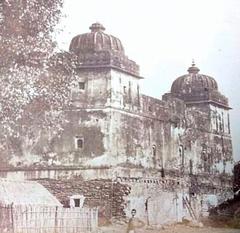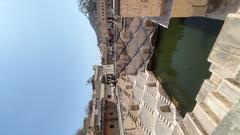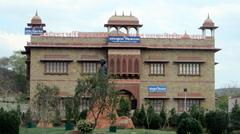Galtaji Monkey Temple Jaipur: Visiting Hours, Tickets, and Historical Sites Guide
Date: 04/07/2025
Introduction to Galtaji Monkey Temple and Its Significance
Nestled within the serene Aravalli Hills just 10 kilometers east of Jaipur, India, Galtaji Temple—commonly known as the “Monkey Temple”—is a striking fusion of spirituality, history, and natural beauty. Revered as an ancient Hindu pilgrimage site, Galtaji is celebrated for its traditional Rajasthani and Mughal-influenced architecture, a series of sacred water tanks (kunds) sustained by perennial natural springs, and its vibrant population of rhesus macaques. Having originated as a spiritual retreat in the early 15th century and later flourishing under the Vaishnava Ramananda Sampradaya, Galtaji has evolved into a prominent religious and cultural center that attracts both devotees and travelers from around the world.
The temple complex is especially well-known for its seven kunds, with the ever-filled Galta Kund holding special significance for ritual bathing and purification during festivals such as Makar Sankranti and Kartik Poornima. Architecturally, the 18th-century temples display Jaipur’s signature pink sandstone masonry, elaborate frescoes, and intricate lattice windows, offering visitors an immersive blend of artistry and devotion. Beyond spiritual practices, Galtaji provides panoramic views, diverse cultural experiences during festivals, and proximity to other Jaipur landmarks like Amber Fort and Nahargarh Fort.
This comprehensive guide covers Galtaji’s historical and religious significance, practical visitor information—including visiting hours, entry fees, accessibility, travel tips, and safety recommendations—and suggested itineraries for a memorable visit to this iconic Jaipur site. For further details, trusted resources such as Hindu Blog, Indian Holiday, and Jaipur Tourism are recommended.
Table of Contents
- Introduction
- Origins and Early History
- Development as a Vaishnava Center
- Architectural Evolution
- Integration with Natural Surroundings
- Religious Significance and Practices
- Festivals and Pilgrimage
- Visiting Hours and Entry Fees
- Accessibility and Getting There
- Facilities, Safety, and Etiquette
- Photography, Trekking, and Activities
- Practical Tips and Responsible Tourism
- FAQs
- Conclusion
- Sources
Origins and Early History
Galtaji is situated in a narrow mountain pass of the Aravalli Hills, surrounded by natural springs and rugged terrain. According to legend, the temple is named after Sage Galav, who performed penance here, resulting in the blessing of a perpetual source of holy water believed to be as sacred as the Ganges. Historically, Galtaji has served as a spiritual retreat for Hindu ascetics since at least the early 15th century, gaining prominence under the Vaishnava Ramananda Sampradaya with leaders like Payohari Krishnadas.
Development as a Vaishnava Center
Under the stewardship of Payohari Krishnadas, Galtaji became a major center for the Vaishnava Ramananda Peeth, attracting saints and followers from across northern India. The site’s spiritual legacy was further enriched by visits from notable saints such as Goswami Nabha Das Ji and Goswami Tulasidas Ji, cementing Galtaji’s reputation as a unifying pilgrimage destination.
Architectural Evolution
Rajasthani and Mughal Influences
The 18th-century temple complex, constructed by Diwan Rao Kriparam during Maharaja Sawai Jai Singh II’s reign, is a testament to Jaipur’s unique architectural style. The blend of Rajasthani and Mughal elements is evident in the intricately carved pillars, rounded pavilion roofs, latticed windows, and vibrant frescoes depicting Hindu mythology (Indian Holiday).
Layout and Design
The complex comprises multiple interconnected shrines, spacious courtyards, and seven sacred kunds spread across several terraces. The open layout allows clear views of the deities and the surrounding hills. Key structures include:
- Hanuman Temple: Known for its eternal flame (Akhand Jyoti) and ornate interiors.
- Surya Temple (Sun Temple): Located at the highest point, offering panoramic city views.
- Shri Gyan Gopalji Temple: Dedicated to Lord Krishna.
- Kirti Stambh: The Tower of Fame, symbolizing spiritual achievement.
Sacred Water Tanks (Kunds)
A defining feature of Galtaji is its seven kunds, natural water tanks fed by springs from the hills. The Galta Kund is the most revered and is believed never to run dry (Indian Holiday). Stone steps descend into the tanks, facilitating ritual bathing and meditation, and the tranquil setting is heightened by the reflection of temple structures on the water’s surface.
Artistic Detailing
Inside the temples, frescoes, murals, and sculpted pillars display floral, geometric, and mythological motifs. Gold and silver inlays, carved brackets, and painted walls narrate stories from Hindu epics like the Ramayana and Mahabharata, reflecting the high level of local craftsmanship (Hinduvism).
Integration with Natural Surroundings
The temple’s harmonious integration with the Aravalli Hills creates a unique environment where nature and architecture coexist. Natural springs feed the kunds, supporting lush vegetation and sustaining the resident wildlife—including the large population of sacred rhesus macaques and langurs that roam the temple grounds. The surrounding cliffs and greenery frame the complex, enhancing its spiritual ambiance (Rajasthan Bhumi Tours).
Religious Significance and Practices
Galtaji is dedicated primarily to Lord Hanuman, with temples for Lord Rama, Krishna, and Surya also present. As a pilgrimage site, it offers daily prayers, rituals, and meditation opportunities. Ritual bathing in the kunds is believed to purify and heal, especially during auspicious festivals.
Festivals and Pilgrimage
Makar Sankranti
Makar Sankranti is the most significant festival celebrated at Galtaji, attracting thousands for ritual bathing, devotional singing, and cultural performances. The festival coincides with the Jaipur Kite Festival, creating a vibrant, communal atmosphere (jaipurtourism.co.in). Local food stalls and markets add to the festivities.
Kartik Poornima and Other Observances
Kartik Poornima, Holi, Hanuman Jayanti, and daily aartis are also marked by special rituals and increased footfall, making these periods particularly lively for visitors (travelogyindia.com).
Visiting Hours and Entry Fees
- Visiting Hours: The temple is generally open daily from 5:00 AM to 9:00 PM, though some sources note 6:00 AM to 6:00 PM as core hours. Early morning and late afternoon visits are recommended for pleasant weather and fewer crowds (thehumbleworld.com).
- Entry Fee: There is no entry fee for the temple. Donations are welcome, and nominal charges may apply for parking or camera use, especially for professional photography (travelsetu.com).
Accessibility and Getting There
- Location: About 10 km east of Jaipur city center, in the Khania-Balaji area (jaipurbuzz.in).
- By Road: Accessible by taxi, auto-rickshaw, or city bus. Rickshaw and taxi drivers can be hired for round trips.
- Nearest Airport: Jaipur International Airport, approximately 10 km away.
- Nearest Railway Station: Bais Godam Junction, around 1 km from the temple.
- Trekking: A scenic hiking route from Suraj Pol Bazar Road offers panoramic views but involves steps and uneven paths.
Note: The temple’s hillside location and stepped terrain may be challenging for visitors with mobility impairments. Assistance is recommended, as wheelchair access is limited.
Facilities, Safety, and Etiquette
Facilities
- Restrooms: Basic facilities are available near the entrance but may not meet international standards. Carry hand sanitizer and tissues.
- Drinking Water: Available on-site, but bottled water is recommended.
- Food: Small stalls offer snacks and tea. For full meals, return to Jaipur city.
Safety and Health
- Monkeys: While sacred and central to the temple’s identity, monkeys can be mischievous. Keep food and valuables secured, avoid feeding them, and observe from a safe distance (thebrutallyhonesttraveler.com).
- General: Wear comfortable, non-slip shoes. Be cautious during the monsoon (July–September) and summer heat.
Etiquette
- Dress modestly (shoulders and knees covered).
- Remove footwear before entering temple interiors.
- Maintain quiet, respectful behavior.
- Photography is usually permitted, but always ask before photographing people or religious ceremonies.
Photography, Trekking, and Activities
- Photography: Allowed in most areas; fees may apply for professional equipment (travelsetu.com).
- Trekking: Trails offer scenic routes to the temple and viewpoints for sunrise/sunset photography (jaipurbuzz.in).
- Guided Tours: Available through local operators, often combined with other Jaipur historical sites.
Practical Tips and Responsible Tourism
- Arrive early for a peaceful atmosphere and cooler temperatures.
- Dress appropriately and respect religious customs.
- Carry water and sun protection.
- Plan return transportation, as cell signal may be limited for ride apps.
- Support the local economy by purchasing souvenirs responsibly and minimizing plastic use.
- Avoid littering and do not pollute the water tanks.
Frequently Asked Questions (FAQs)
Q: What are the Galtaji Temple visiting hours?
A: The temple is open daily from 5:00 AM to 9:00 PM (some sources state 6:00 AM to 6:00 PM).
Q: Is there an entry fee for Galtaji Temple?
A: No, entry is generally free, though small charges may apply for cameras or parking.
Q: Are the monkeys safe?
A: Monkeys are a highlight but can be mischievous. Keep valuables secure and do not provoke or feed them.
Q: Is the temple accessible for differently-abled visitors?
A: Accessibility is limited due to steps and uneven terrain; assistance is recommended.
Q: What is the best time to visit?
A: October to March offers pleasant weather; major festivals like Makar Sankranti bring vibrant celebrations.
Q: Can I take guided tours?
A: Yes, but only arrange through reputable agencies. Politely decline unsolicited offers on-site.
Conclusion
Galtaji Temple in Jaipur is a captivating blend of history, spirituality, and nature, offering a unique experience at one of Rajasthan’s most iconic sacred sites. Its intricate architecture, sacred kunds, resident monkeys, and vibrant festivals provide both cultural enrichment and peaceful reflection. By following the practical information and safety tips outlined here, visitors can enjoy a safe and rewarding journey. For the latest travel updates and personalized experiences, download the Audiala app and follow us on social media.
Summary of Key Information and Visitor Recommendations
Galtaji Temple exemplifies India’s spiritual heritage, architectural brilliance, and harmony with nature. Free entry, broad visiting hours, and vibrant festivals—especially Makar Sankranti—make it a must-visit destination in Jaipur. While the terrain presents some accessibility challenges, careful planning ensures a memorable experience. Respect local customs, follow safety guidelines, and explore nearby attractions to make the most of your visit. For in-depth planning, consult authoritative travel resources like Travelogy India and Thrillophilia.
Sources and Official Links for Further Information
- Wikipedia
- Hindu Blog
- Indian Holiday
- Jaipur Tourism
- Jaipurbuzz.in
- TempleYatri
- JaipurThruMyLens
- Rajasthan Bhumi Tours
- Hinduvism
- TravelSetu
- Tusk Travel
- The Brutally Honest Traveler
- Laure Wanders
- Travel Triangle
- Travelogy India
- Thrillophilia
- Kalyan Tours Udaipur







